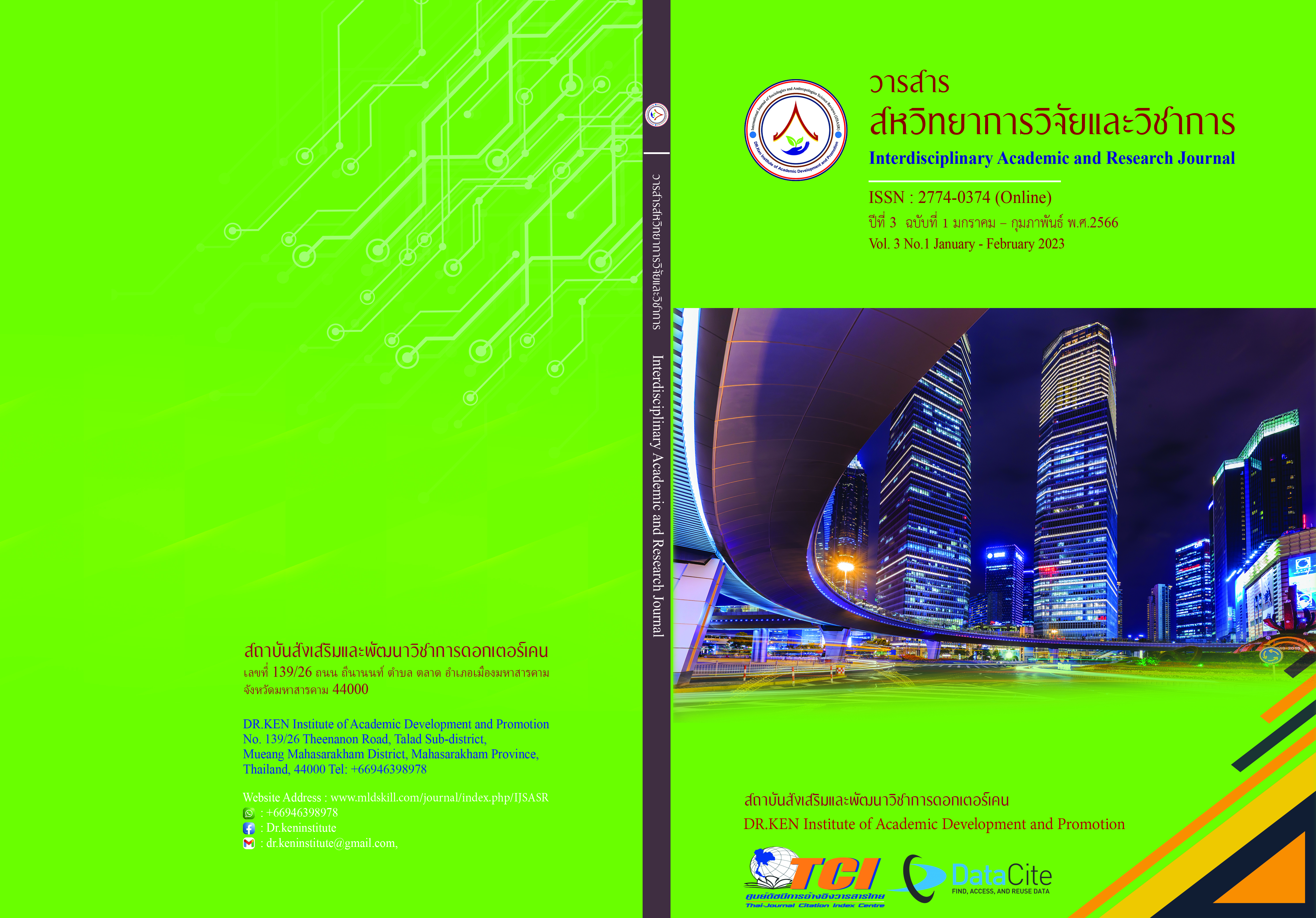Human Resource Development for Work Efficiency Case Study: Rajamangala University of Technology Rattanakosin Nakhon Pathom Province
DOI:
https://doi.org/10.14456/iarj.2023.41Keywords:
Human Resource Development;, Work EfficiencyAbstract
Working in every organization is aware of process modification or how to work to be efficient and effective. Strategies for creating success at work, techniques for developing work efficiency as well as how to work to be happy. This shows that various organizations have the same opinion that the organization will thrive or develop towards excellence. One important thing is that quality workers and able to work for maximum efficiency. In work, no matter what we do, we must be happy to work. Although sometimes the work may be exhausting. But after seeing the success of the work will be able to overlook those obstacles. To work not only has to be happy but also to work efficiently. In working, each person has a different way of working. It depends on the concept and implementation. Therefore, those who are efficient at work are those who are smart at learning. Know how to accomplish tasks in a shorter time and with fewer mistakes. That is less investment. But getting more returns in terms of economics may focus on cost-effectiveness or cost-effectiveness in operation. Thus, Human resource development for efficiency consists of education, training, orientation, and assignment. group work Performance appraisal is the development of competency suitable for performance. and develop the operational potential for expertise and continuity It will result in the organization being able to compete and keep pace with changes. Because of the advancement of various technologies as well as techniques for working, which are always changing.
References
กองบริหารงานบุคคล สำนักงานอธิการบดี มหาวิทยาลัยเทคโนโลยีราชมงคลรัตนโกสินทร์. (2554). แผนการบริหารและพัฒนาบุคลากรสายวิชาการและสายสนับสนุน ประจำปี 2564. มหาวิทยาลัยเทคโนโลยีราชมงคลรัตนโกสินทร์.
กาญจน์นภา ฉวีรักษ์ (2558). ความสัมพันธ์ระหว่างแรงจูงใจในการปฏิบัติงานและคุณภาพชีวิตการทำงานของบุคลากรสถาบันโรคทรวงอก. วิทยานิพนธ์สังคมสงเคราะห์ศาสตรมหาบัณฑิต,มหาวิทยาลัยธรรมศาสตร์
โชติกา ระโส.(2555). แรงจูงใจในการปฏิบัติงานของบุคลากร มหาวิทยาลัยราชภัฏนครสวรรค์. วิทยานิพนธ์ศึกษามหาบัณฑิต, มหาวิทยาลัยศรีนครินทรวิโรฒ
ประเวศน์ มหารัตน์สกุล. (2547). การจัดการทรัพยากรมนุษย์. กรุงเทพฯ: สมาคมส่งเสริมเทคโนโลยีไทยญี่ปุ่น.
สมใจ ลักษณะ. (2547). การพัฒนาประสิทธิภาพในการทำงาน. พิมพ์ครั้งที่ 4, กรุงเทพฯ: สถาบันราชภัฎสวนสุนันทา.
สมาน รังสีโยกฤษฎ์. (2530). ความรู้ทั่วไปเกี่ยวกับการบริหารงานบุคคล. พิมพ์ครั้งที่ 13 กรุงเทพมหานคร : สวัสดิการสำนักงาน กพ.
สิริวดี ชูเชิด. (2556). การศึกษาสภาพการบริหารงานกิจการนักศึกษามหาวิทยาลัยราชภัฏสวนดุสิต.บริหารธุรกิจมหาบัณฑิต: มหาวิทยาลัยศรีปทุม.
สุธินี ฤกษ์ชำ. (2558). การพัฒนาทรัพยากรมนุษย์: หลักการและการประยุกต์. กรุงเทพฯ: สำนักพิมพ์แห่งจุฬาลงกรณ์มหาวิทยาลัย.
อุทัย หิรัญโต (2525). เทคนิคการบริหาร. กรุงเทพฯ : ทิพย์อักษรการพิมพ์.
Berelson, B., & Steiner, G. A. (1964). Human behavior: An inventory of scientific findings. Harcourt, Brace & World.
Gellerman, Saul. W. (1976). Working with People: Human Resources Management in Action. Massachusetts: CBI Publishing Company, Inc.
Gilmer, Von Haller, B. (1967). Industrial psychology. New York: Mc Graw - Hill.
Harrington Emerson. (1931). Organizational Behavior Singapore: McGraw-Hill Book Co- Singapore.
Heneman, H. G., Schwab, D. P., Fossum, J. A., & Dyer, L. D. (1983). Personnel/ Human Resource Management. Illinois: Irwin.
Herzberg, F., et al. (1957). Job Attitude: Review of Research and Opinion. Pittsburgh: Psychological Series of Pittsburgh.
John D. Millet. (1954). Management in the Public Service. New York: Mc Graw Hill Book, Company
Kinicki, A., & Williams, B., (2008). Management. 3rd edition, New York: McGraw-Hill.
Petersen, E., & Plowman, G. E. (1953). Business Organization and Management. Homewood, Illinois: Irwin.
Pigors: G., & Meyer, C. (1969). Personnel Administration. 6"ed. New York: McGrew-Hill.
Plowman, E. & Peterson, C. (1989). Business Organization and Management. Illinois: Irwin.
Ryan, T. A., & Smith: C. (19S4). Principles of industrial psychology. New York: Ronald Press.
Simon, H. A. (1960). Administrative Behavior. New York: Macmillan.
Slocum, J. W. (1971). Motivation in Managerial Level: Relationship of Need Satisfaction to Job Performance. Journal of Applied Psychology. 55:312-316.
Vroom, V. H. (1964). Work and Motivation. New York: John Wiley and Son, Inc.
Zaleanick, et al. (1958). Motion productivity and Satisfaction of workers. Massachusettes: Division of Research, Harward University.
Downloads
Published
How to Cite
Issue
Section
License
Copyright (c) 2023 กัณณ์ศศิชา เนาว์เย็นผล, อำนวย บุญรัตนไมตรี, ฐิติมา โห้ลำยอง, สมคิด ดวงจักร์

This work is licensed under a Creative Commons Attribution-NonCommercial-NoDerivatives 4.0 International License.
Copyright on any article in the Interdisciplinary Academic and Research Journal is retained by the author(s) under the under the Creative Commons Attribution-NonCommercial-NoDerivatives 4.0 International License. Permission to use text, content, images, etc. of publication. Any user to read, download, copy, distribute, print, search, or link to the full texts of articles, crawl them for indexing, pass them as data to software, or use them for any other lawful purpose. But do not use it for commercial use or with the intent to benefit any business.
















.png)


